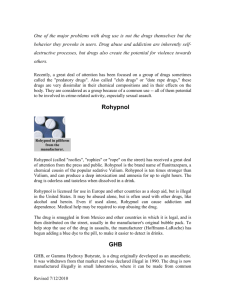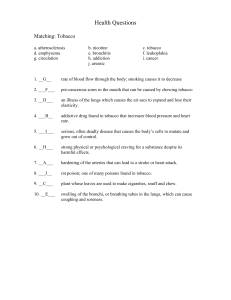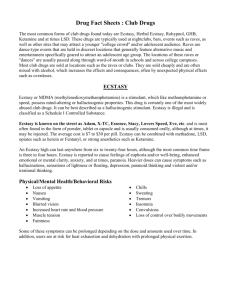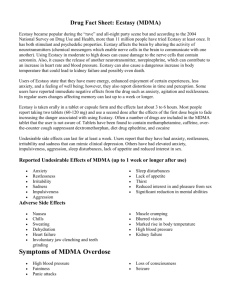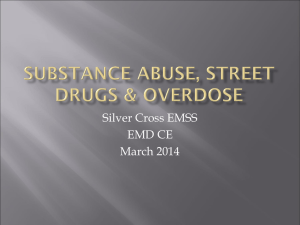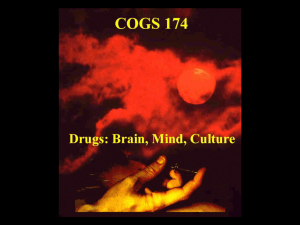Rave Drugs: Pharmacological considerations
advertisement
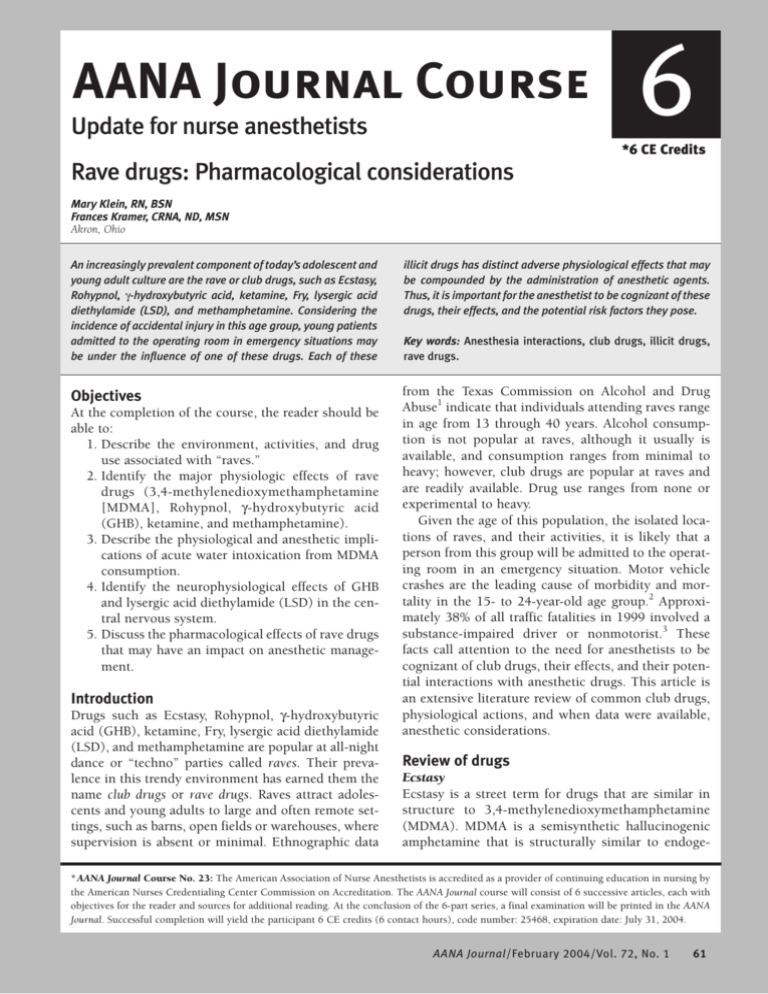
AANA Journal Course Update for nurse anesthetists 6 *6 CE Credits Rave drugs: Pharmacological considerations Mary Klein, RN, BSN Frances Kramer, CRNA, ND, MSN Akron, Ohio An increasingly prevalent component of today’s adolescent and young adult culture are the rave or club drugs, such as Ecstasy, Rohypnol, g-hydroxybutyric acid, ketamine, Fry, lysergic acid diethylamide (LSD), and methamphetamine. Considering the incidence of accidental injury in this age group, young patients admitted to the operating room in emergency situations may be under the influence of one of these drugs. Each of these illicit drugs has distinct adverse physiological effects that may be compounded by the administration of anesthetic agents. Thus, it is important for the anesthetist to be cognizant of these drugs, their effects, and the potential risk factors they pose. Objectives from the Texas Commission on Alcohol and Drug Abuse1 indicate that individuals attending raves range in age from 13 through 40 years. Alcohol consumption is not popular at raves, although it usually is available, and consumption ranges from minimal to heavy; however, club drugs are popular at raves and are readily available. Drug use ranges from none or experimental to heavy. Given the age of this population, the isolated locations of raves, and their activities, it is likely that a person from this group will be admitted to the operating room in an emergency situation. Motor vehicle crashes are the leading cause of morbidity and mortality in the 15- to 24-year-old age group.2 Approximately 38% of all traffic fatalities in 1999 involved a substance-impaired driver or nonmotorist.3 These facts call attention to the need for anesthetists to be cognizant of club drugs, their effects, and their potential interactions with anesthetic drugs. This article is an extensive literature review of common club drugs, physiological actions, and when data were available, anesthetic considerations. At the completion of the course, the reader should be able to: 1. Describe the environment, activities, and drug use associated with “raves.” 2. Identify the major physiologic effects of rave drugs (3,4-methylenedioxymethamphetamine [MDMA], Rohypnol, g-hydroxybutyric acid (GHB), ketamine, and methamphetamine). 3. Describe the physiological and anesthetic implications of acute water intoxication from MDMA consumption. 4. Identify the neurophysiological effects of GHB and lysergic acid diethylamide (LSD) in the central nervous system. 5. Discuss the pharmacological effects of rave drugs that may have an impact on anesthetic management. Introduction Drugs such as Ecstasy, Rohypnol, g-hydroxybutyric acid (GHB), ketamine, Fry, lysergic acid diethylamide (LSD), and methamphetamine are popular at all-night dance or “techno” parties called raves. Their prevalence in this trendy environment has earned them the name club drugs or rave drugs. Raves attract adolescents and young adults to large and often remote settings, such as barns, open fields or warehouses, where supervision is absent or minimal. Ethnographic data Key words: Anesthesia interactions, club drugs, illicit drugs, rave drugs. Review of drugs Ecstasy Ecstasy is a street term for drugs that are similar in structure to 3,4-methylenedioxymethamphetamine (MDMA). MDMA is a semisynthetic hallucinogenic amphetamine that is structurally similar to endoge- * AANA Journal Course No. 23: The American Association of Nurse Anesthetists is accredited as a provider of continuing education in nursing by the American Nurses Credentialing Center Commission on Accreditation. The AANA Journal course will consist of 6 successive articles, each with objectives for the reader and sources for additional reading. At the conclusion of the 6-part series, a final examination will be printed in the AANA Journal. Successful completion will yield the participant 6 CE credits (6 contact hours), code number: 25468, expiration date: July 31, 2004. AANA Journal/February 2004/Vol. 72, No. 1 61 nous catecholamines4 and chemically related to mescaline and amphetamine.5 This psychoactive substance, with stimulant and hallucinogenic properties, also is known on the street as E, XTC, eccy, the LoveDrug, X, Clarity, and Adam. Merck Pharmaceutical Company (Wilmington, Del) manufactured MDMA in 1914 and marketed it as an appetite suppressant, but it was not used commonly until the 1970s as an adjunct for psychotherapy.6 Ecstasy is swallowed or inserted rectally (referred to as shafting or shelving), and it is absorbed readily from the gastrointestinal tract and reaches peak plasma concentration in 2 hours.7 The illicit manufacturing of this drug results in true doses that may range from almost 0 to 100 mg.8 Metabolism occurs mainly by the liver enzyme CYP2D6, and its half-life is around 8 hours.9 Currently, MDMA is a Schedule I drug under the Controlled Substances Act.10 • Neurological effects. Some of the immediate effects of MDMA ingestion include increased body temperature, increased neuromuscular activity, and profound sweating. Subarachnoid hemorrhage, cerebral infarction, and seizure activity have been documented after MDMA ingestion.4,11-14 Several case reports have attributed seizures to severe hyponatremia resulting from the profound sweating coupled with incredibly large amounts of water consumption (water intoxication).15-18 In many cases, cerebral edema resulted from the large amounts of water ingested by the patients.19 Pathology reports of persons suffering a rapid MDMArelated death describe disseminated intravascular coagulation, neuronal degeneration, and cerebral edema as specific causes.8 Prolonged MDMA use has been associated with globus pallidus necrosis due to serotonin receptor stimulation and vasospasm.20 The increased neuromuscular activity associated with MDMA ingestion includes jaw clenching, teeth grinding, and vigorous dancing. People who have ingested MDMA often suck on pacifiers to minimize teeth grinding. The vigorous dancing also contributes negatively to hyperthermia and causes muscle degradation. • Cardiovascular effects. MDMA causes sympathomimetic stimulation, leading to increased norepinephrine and dopamine release, heart rate, blood pressure, systemic vascular resistance, and myocardial oxygen consumption.21,22 Additional MDMA-related cardiovascular effects are arrhythmias and severe hypotension, which may be due to catecholamine depletion21 or MDMA-induced autonomic dysregulation.23 Several case reports have documented initial tachycardia and hypertension on admission to the emergency department, followed by hypotension and low cardiac output.13,24 There also have been reports of arterial vasospasm leading to nonhemorrhagic cerebral vascular acci62 AANA Journal/February 2004/Vol. 72, No. 1 dents,20 myocardial ischemia, and myocardial infarction.21 Changes in coagulation due to alterations in the endothelial lining of the coronary arteries and the relatively rapid development of atherosclerosis related to MDMA use also may lead to myocardial ischemia and infarction.21 Long-term MDMA use may lead to the development of irreversible cardiomyopathy resulting from repeated and prolonged exposure to high levels of catecholamines and myocyte necrosis.8,21 • Respiratory effects. Patients who have ingested MDMA have a tendency to dance extremely vigorously for long periods and consume large amounts of water. This overzealous consumption of water may result in the potentially fatal effects of water intoxication and pulmonary edema.18,25 • Hyperthermia. Profound hyperthermia is one of the most common severe toxic effects of MDMA use.8,11-13,22,24,25 Temperatures have been reported as high as 42°C (107.5°F; axillary).24 MDMA acts on the serotoninergic pathway that affects thermoregulation.8 Patients who are predisposed to the development of malignant hyperthermia after receiving succinylcholine or volatile anesthetic agents may have a similar predisposition when they have ingested MDMA.25 This theory is supported by a study that assessed in vitro muscle contracture and malignant hyperthermia and found that MDMA elevated the myoplasmic calcium concentration and potentiated halothane- and caffeine-induced skeletal muscle contractures, which are the same mechanisms that induce malignant hyperthermia.26 • Hepatic effects. The abuse of MDMA has led to hepatitis, accelerated hepatic fibrosis, and possible fulminant liver failure.27,28 Hepatonecrosis may be severe enough to cause an almost total loss of hepatocytes,28 and several deaths associated with fulminant liver failure after MDMA consumption have been documented.8 • Renal effects. MDMA-related acute renal failure has been documented due to rhabdomyolosis and disseminated intravascular coagulation.8,13,29 In patients using MDMA, serum creatinine kinase levels have been documented to rise sharply for up to 4 days after admission to the hospital.30 Because of the substantial physiological effects of MDMA, anesthetic considerations are important for patients with a history of or currently using MDMA. Fluid and electrolyte levels must be evaluated carefully, and any acute hyponatremia or water intoxication should be treated. Providers should anticipate autonomic dysregulation in patients acutely intoxicated with MDMA. Wide swings in blood pressure and tachycardia should be avoided because of early coronary atherosclerotic disease, increased coronary and cerebral arterial vasospasm, and cardiomyopathy in long-term MDMA users. Volatile agents and suc- cinylcholine should be avoided in patients with a history of MDMA-related hyperthermia. Anesthetic drugs metabolized through the liver and eliminated though the kidney may have prolonged effects due to hepatitis and acute renal failure in MDMA users. Rohypnol Rohypnol, the brand name for flunitrazepam, is classified as a benzodiazepine. Hoffmann-LaRoche, located in Nutley, NJ, manufactures Rohypnol in 1and 2-mg tablets, primarily in Europe and Latin America, and it is the No. 1 sleep aid in the world. Rohypnol is not manufactured or approved for medical use in the United States and is a Schedule IV drug under the Controlled Substance Act with Schedule I penalties for illegal possession, importation, or distribution in the United States. It is smuggled into the United States from Mexico. To combat its illicit use as another date-rape drug, Hoffmann-LaRoche reformulated the drug so that it releases blue dye when added to liquid. Street names for Rohypnol include Circles, Mexican Valium, Rib, Roach 2, Roofies, Roopies, Rope, Roaches, and Ruffies.31 The effects of Rohypnol, while similar to those of diazepam, are approximately 7 to 10 times greater.32 Rohypnol is ingested orally, and effects are observed within 30 minutes, peak within 1 to 2 hours, and continue for an average of 8 to 10 hours. At higher doses and when combined with other drugs, the effects may persist for 24 hours. The drug has a half-life of 19 to 23 hours. • Neurological effects. Neurological effects of Rohypnol include sedation, dizziness, memory impairment, decreased coordination, muscle relaxation, decreased blood pressure, slurred speech, impaired judgment, amnesia, loss of inhibitions, loss of consciousness, visual disturbances, and nausea. Some people may experience paradoxical effects, such as excitability, aggressive behavior, or both. g-hydroxybutyric acid The drug GHB is a naturally occurring short-chain fatty acid metabolite of g-aminobutyric acid (GABA). GHB is a central nervous system depressant that produces rapid eye movement (REM) sleep within 15 minutes and was used as an anesthetic during the 1950s. Its usefulness as an anesthetic diminished due to the severe nausea, vomiting, and seizures; lack of analgesic properties; and the development of new anesthetic agents. GHB still is used as an adjunct to anesthesia in Europe; however, due to its highly addictive characteristics and increased use for criminal activity, it is currently classified as a Schedule I drug in the United States.33 GHB is found commonly at nightclubs and underground rave parties, and it is used by body builders for its purported anabolic effects. GHB is easily and clandestinely manufactured in the United States. At least 125 Web sites offer recipes for GHB using everyday house cleaning products, such as floor stripper and baking soda. These ingredients are stirred and may be heated. It can be produced as a clear, colorless, odorless liquid that is slightly thicker than water. It also can come as a white powder, tablet, or capsule. The liquid form commonly is placed in fruity drinks or soda to mask the slightly salty taste. GHB commonly is dispensed in eye drop, breath mint, food coloring, and purse-sized hairspray containers. Other containers include hollowed out lip balm tubes, ice cube trays, and tampons. A pop bottle capful is sold for $10 to $20. Common street names are G (most common), Gamma-OH, Liquid E, Fantasy, Georgia Home Boy, Grievous Bodily Harm, Liquid X, and Liquid Ecstasy (note that GHB is not ecstasy). Additional street names include Scoop, Water, Everclear, Great Hormones at Bedtime, GBH, Soap, Easy Lay, Salty Water, G-Riffick, Cherry Meth, and Organic Quaalude.34 The effects of GHB occur in 10 to 30 minutes of ingestion and last 3 to 6 hours, depending on the dose. GHB exhibits nonlinear elimination kinetics, meaning that its half-life increases with the dose. High doses result in a much higher plasma level than would be predicted from the plasma levels resulting from lower doses.10 The volume of distribution of GHB is small, and it is rapidly absorbed from oral, intravenous, and intraperitoneal routes.35 GHB is metabolized completely into carbon dioxide and water, with no residue of toxic metabolites,36 making detection difficult. There is no available blood toxicology screen. Most GHB is excreted during the first hours after ingestion.37 Urinalysis must be done within 12 hours of ingestion and usually requires a reference testing laboratory. The toxic effects of GHB are potentiated by alcohol, opiates, barbiturates, and benzodiazepines. GHB alone, and in combination with other substances, has caused deaths.10 In 2000, the US Drug Enforcement Agency reported 71 deaths and 7,200 overdoses related to GHB.31 • Neurological effects. GHB was isolated during research on GABA and is found in all body tissues, with the highest concentration in the brain.22 Research indicates that GHB produces deep, reversible depression of cerebral metabolism and induces hypothermia through decreases in metabolic heat production and increases peripheral heat loss through the skin. GHB increases dopamine, serotonin, and acetylcholine levels in the brain; exerts an effect on the opioid system; and easily crosses the blood-brain barrier. It is involved in the regulation of GABA, dopamine, serotonin, and acetylcholine. It has been theorized AANA Journal/February 2004/Vol. 72, No. 1 63 that GHB mimics the effects of GABA, binding to specific GHB receptor sites and behaving as a neurotransmitter,38-40 but the precise functions are complex and not yet fully understood. The desired effect of GHB is euphoria, producing a trancelike state and mimicking physiologic sleep. There is a lack of inhibition and sexual arousal, and the person appears extremely intoxicated. It also may protect the central nervous system from injury during hypoxic episodes, hibernation states, and/or states of increased metabolic demands.41 Other documented effects of GHB include amnesia and hypotonia at doses of 10 mg/kg of body weight, a normal sequence of REM and non-REM sleep at doses of 20 to 30 mg/kg of body weight, and anesthesia at doses of approximately 50 mg/kg of body weight. At toxic levels, loss of consciousness, memory impairment, confusion, loss of inhibition, seizures, dizziness, extreme drowsiness, stupor, coma, agitation, nausea, and visual disturbances can occur.42 A telltale sign of toxic effects is body jerking with “head snap.” Moreover, with its potency as a central nervous system depressant, GHB is especially dangerous when used in combination with alcohol. • Respiratory and cardiovascular effects. There seems to be a fine line between the dose of GHB needed to achieve the desired effect and the amount that leads to coma. GHB causes severe respiratory depression and acidosis at levels greater than 50 mg/kg of body weight. At these doses, GHB also can decrease cardiac output due to slight decreases in stroke volume and heart rate. Physostigmine has been suggested as a therapeutic option to treat GHB toxicity. However, there is no antidote for GHB overdose, and treatment is restricted to nonspecific supportive care: airway maintenance with intubation and ventilation.40 Providers must observe for signs and symptoms of severe, life-threatening withdrawal, which include hypertension, tachycardia, and seizures. Failure to seek medical help has led to GHB-related deaths. Morbidity and mortality is increased when GHB is combined with alcohol.40 There is most likely an underestimate of GHB-related deaths, since GHB has a short half-life and usually is not looked for as a cause of death. Some GHB homicides have occurred. In a survey of emergency department patients who had used GHB, 47% had taken GHB (or a precursor) to get high, 9% were dependent on GHB, 36% took it for other psychological effects, and 8% used GHB in a suicide attempt. Of these emergency department patients, 93% were white, and two thirds were younger than 25 years.10 Ingestion of the final product also has caused esophageal injury when the caustic soda was not neutralized.43 There is no direct evidence of adverse effects on the hepatic or renal systems. 64 AANA Journal/February 2004/Vol. 72, No. 1 Ketamine In 1962, the University of Michigan developed a safe, new anesthetic induction agent, ketamine. It currently is marketed by Parke-Davis as Ketalar and is a Schedule III drug. It is a phencyclidine (PCP) derivative combining sedative, anesthetic, amnesic, and analgesic properties, but with one tenth the potency. It is used for medicinal and veterinary purposes when central nervous system dissociation is desired. When used as directed, ketamine can be given intramuscularly, intravenously, or orally. When used illicitly, its common form is a white powder, similar in appearance to cocaine, that can be snorted; however, it also can be taken orally, intravenously, intramuscularly, or smoked.44 Street names for ketamine are Ket, K, Special K, Green, 1980 Acid, Super C, Vitamin K, Super Acid, Special LA Coke, Baby Food, God, Jet, Honey Oil, Blast, and Gas.33 The attraction to its users is the hallucinogenic effects described as an “out of body experience” similar to that produced by LSD and PCP. Some common effects of ktamine are delirium, amnesia, depression, and long-term memory and cognitive difficulties. Due to its dissociative effect, it is being used increasingly as a date-rape drug.32 • Respiratory and cardiovascular effects. In a normocapnic patient, ketamine will increase cerebral blood flow and intracranial pressure. It can slightly enhance laryngeal reflexes, increase salivary and tracheobronchial secretions, increase muscle tone, cause bronchodilation, and increase or decrease respirations. At high doses, respiratory arrest can occur. The sympathetic system is up-regulated and produces increased systemic and pulmonary artery pressure, cardiac output, and heart rate.45 Fry The first reported use of Fry, an altered form of marijuana, occurred in the 1970s in New Jersey. These PCPlaced, formaldehyde-soaked marijuana cigarettes are known as Wack or Illy in Connecticut, Hydro in New York, Wet in Philadelphia, and Fry in Texas. They are also known as Fry Sticks, Amp, Water-water, Formaldehyde, Wet-wet, Wetdaddy, Drank, and Fry-sweets.46 Formaldehyde embalming fluid is easily accessible through retail sale. It also can be obtained from the staff of morgues, hospitals, and funeral homes. Embalming fluid consists of formaldehyde, methanol, and ethanol. Formaldehyde is a relatively stable organic gas at standard room temperature.47 However, at temperatures greater than 300°C (571.6°F), it breaks down to carbon monoxide and water. Methanol is a main component of disinfectants, epoxy, synthetic fibers, and antifreeze. The primary side effect of smoking these PCP- laced, formaldehyde-soaked marijuana or tobacco cigarettes is toxic psychosis. Other effects include hallucinations, delusions, panic, paranoia, increased sexual arousal, and loss of consciousness. Side effects associated with inhalation of embalming fluid are disorganized thoughts, decreased attention span, psychomotor agitation, and up-regulation of the sympathetic nervous system. When admitted to an emergency department, patients who have smoked this drug exhibit severe dysphoric effects. Although postulated as an interaction between tetrahydrocannabinal and formaldehyde, these adverse reactions are very similar to PCP reactions.48 Exposure to embalming fluid can cause bronchitis, body tissue destruction, impaired coordination, inflammation, brain and lung damage, and sores in the throat, nose, and esophagus.49 Lysergic acid diethylamide LSD is a hallucinogenic drug that was discovered in 1938 and is made from the D-lysergic acid diethylamide found in ergot, a fungus that grows on rye and other grains. It was popular during the 1960s and is regaining popularity. LSD also is known as Acid, Pig, Orange Budda, Jetsons, Pink Turbos, Microdots, Purple Haze, Trip, and Yellow Baby Domes. Today’s LSD is more powerful and may cause seizure activity for more than 60 days after ingestion. LSD is clear, odorless, and tasteless. A single dose, or hit, usually is taken orally in the form of pills, blotter paper, or liquid. It also can be administered intranasally, intravenously, by inhalation, and via the conjunctiva. According to US Drug Enforcement Agency reports, the usual dose for 1 hit ranges from 20 to 80 µg.10 Hallucinogenic effects start about 30 minutes to 1 hour after consumption, peak within 3 to 5 hours, and may last up to 12 hours. Some neurological complications include acute psychotic reactions, cerebral vasospasm, flashbacks, panic attacks, tremors, and seizures.49 Studies have shown that these complications are due to the effect of LSD on the serotoninergic and dopaminergic systems.50 It is chemically similar to serotonin, causing serotonin release and radical changes to mentation by its affects on the brainstem. LSD also activates the sympathetic nervous system, causing dilated pupils; elevated heart rate, blood pressure, and core body temperature; and sweating. Methamphetamine Methamphetamine is a synthetic, noncatacholamine derivative of amphetamine that exerts stimulatory effects on the central nervous and cardiovascular systems. Also known as Speed, Meth, Chalk, Ice, Crystal, Crank, Fire, and Glass, methamphetamine can be smoked, sniffed, swallowed, or taken intravenously. Effects and time of onset vary depending on the route. Methamphetamine is a Schedule I drug and has a high incidence of tolerance. This characteristic helps explain its high addiction rate, similar to the effects of cocaine. Its half-life is generally 12 hours. “Ice,” the smokable form, is of high purity and can exert effects for 12 hours or more. • Neurological effects. In the central nervous system, methamphetamine up-regulates the sympathetic nervous system, stimulating the release and minimizing the reuptake of endogenous catacholamines.51 Heart rate and blood pressure are increased, mood and libido are elevated, while appetite and fatigue are decreased.52 Methamphetamine is thought to cause a surge of dopamine release immediately following a single dose, damaging the dopaminergic nerve terminals in the brain. It also has been found to damage serotoninreleasing neurons, possibly to a greater extent than the dopaminergic neurons.53 In addition, methamphetamine may damage the smaller cerebral arteries. • Cardiovascular effects. Long-term methamphetamine use seriously affects cardiac tissue. Increased interstitial fibrosis of the left ventricle may occur from long-term exposure to catacholamines and the resultant enhanced collagen release.51 Cardiac myocyte hypertrophy may occur, leading to left ventricular hypertrophy, decreased cardiac wall compliance, and decreased end-diastolic volume.54 • Other effects. Hyperthermia is also associated with methamphetamine overdose.53 Other effects include uncontrolled movements, acne, and dry, itchy skin. Anesthetic considerations include heart rate and blood pressure stability especially in chronic methamphetamine users because of cerebral vascular damage, left ventricular hypertrophy, cardiac fibrosis, and decreased cardiac compliance. Conclusions Seven drugs commonly used in the rave culture have been reviewed. The clinically significant physiologic effects on the neurological, cardiovascular, hepatic, renal, and respiratory systems of these illicit drugs are summarized in the Table. Anesthesia providers must be aware of the population at risk for abusing the drugs, the common drugs of abuse, and the possible effects of these drugs on the effects of commonly administered anesthetic agents. REFERENCES 1. Kotarba JA. Research Briefs. The Rave Scene in Houston, Texas: An Ethnographic Analysis. Austin, Tex: Texas Commission on Alcohol and Drug Abuse. October 1993. 2. National Safety Council. Report on Injuries in America, 2001. Available at: http://www.nsc.org/library/rept2000.htm. Accessed October 22, 2002. 3. Drug Abuse Warning Network. Washington DC: Substance Abuse and Mental Health Services Administration, Department of Health and Human Services. Available at: http://www.samhsa.gov/oas/ dawn.htm. Accessed September 30, 2002. 4. Manchanda S, Connolly MJ. Cerebral infarction in association AANA Journal/February 2004/Vol. 72, No. 1 65 66 AANA Journal/February 2004/Vol. 72, No. 1 Euphoria, decreased CMRO2, loss of consciousness, impaired memory, confusion, decreased inhibitions, tonicclonic activity, myoclonus, dizziness, coma, agitation, visual disturbances Increased cerebral blood flow and intracranial pressure; hallucinations No known clinically significant effects No known clinically significant effects Increased heart rate, cardiac No known clinically output, stroke volume, significant effects blood pressure, positive airway pressure No known clinically significant effects No known adverse effects Up-regulated sympathetic nervous system Elevated heart rate, blood pressure Up-regulated sympathetic No known clinically nervous system, elevated significant effects heart rate, blood pressure; left ventricular hypertrophy, cardiac fibrosis and failure with long-term use Enhanced laryngeal reflexes, increased airway secretions; bronchial smooth muscle relaxation; respiratory arrest at high doses Bronchitis No known clinically significant effects No known clinically significant effects No known clinically significant effects No known adverse effects No known clinically significant effects No known clinically significant effects 80% of Rohypnol metabolite excreted via kidney Increased serum creatinine kinase and creatine phosphokinase levels, rhabdomyolosis, renal failure (with elevated myoglobin level) Renal Decreased heart rate, cardiac output, stroke volume, blood pressure Altered by first-pass effect in liver; effects magnified in combination with drugs that bind to P-450 enzyme Elevated liver function test results, hepatitis, hepatonecrosis and fibrosis, fulminant liver failure Hepatic Severe respiratory depression or arrest *CMRO 2 indicates cerebral metabolic rate of oxygen consumption; SVR, systemic vascular resistance. Dysphoria, disorganized thoughts, decreased attention, agitation Lysergic acid Acute psychotic reactions, diethylamide (or cerebral vasospasm, LSD) flashbacks, panic attacks, tremors, and seizures; dilated pupils, hallucinations, suicidal ideation Methamphetamine Elevated mood and libido; decreased appetite and fatigue Fry Ketamine g-hydroxybutyric acid (or GHB) Respiratory depression Hypotension Sedation, dizziness; decreased coordination, muscle tone, inhibitions, and consciousness; visual disturbances, excitability, delusions, rages, nightmares, psychosis, and aggressiveness; anterograde amnesia, coma, ataxia Rohypnol Increased levels of endogenous catecholamines; increased heart rate, blood pressure, SVR, cardiac oxygen consumption, arrhythmia; hypotension, decreased cardiac output (late); myocardial infarction, myocyte necrosis Cardiovascular Seizures, cerebral edema, neuron degeneration and necrosis, and hemorrhagic and ischemic cerebrovascular accident Pulmonary edema Respiratory Ecstasy (3,4methylenedioxymethamphetamine, or MDMA) Neurological Table. Clinically significant effects of selected illicit drugs* Hyperthermia with overdose Hyperthermia, sweating Sores in throat, nose, esophagus No known clinically significant effects Enhanced central nervous system depression with concurrent use of neuroleptic, hypnotic, anxiolytic, barbiturate, antidepressant, narcotic, antiepileptic, anesthetic, and antihistamine drugs Hypothermia, esophageal injury Hyperthermia (similar to malignant hyperthermia) Other with ecstasy abuse. Postgrad Med. 1993;69:874-889. 5. Drug War Facts. Ecstasy: What the Evidence Shows. Available at: www.drugwarfacts.org/ectasy.html. Accessed April 30, 2002. 6. Suarez RV, Riemersma R. “Ecstasy” and sudden cardiac death. Am J Forensic Med Pathol. 1988;9:339-341. 7. Mas M, Farre M, de la Torre R, et al. Cardiovascular and neuroendocrine effects and pharmacokinetics of 3,4-methylenedioxymethamphetamine in humans. J Pharmacol Exp Ther. 1999;290:136-145. 8. Milroy CM, Clark JC, Forrest ARW. Pathology of deaths associated with “Ecstasy” and “Eve” misuse. J Clin Pathol. 1996;49:149-153. 9. Kalant H. Pharmacology and toxicology of “Ecstasy” (MDMA) and related drugs. CMAJ. 2001;165:917-928. 10. Trends and Statistics page. National Institute on Drug Abuse web site. Available at: http://www.nida.nih.gov. Accessed October 22, 2002. 11. Nimmo SM, Kennedy BW, Tullett WM, et al. Drug-induced hyperthermia. Anaesthesia. 1993;48:892-895. 12. Singarajah C, Lavies NG. An overdose of Ecstasy, a role for dantrolene. Anaesthesia. 1992;47:686-687. 13. Hall AP, Lyburn ID, Spears FS, Riley B. An unusual case of Ecstasy poisoning. Intensive Care Med. 1996;22:670-671. 14. Gledhill JA, Moore DF, Bell D, Henry JA. Subarachnoid haemorrhage associated with MDMA abuse. J Neurol Neurosurg Psychiatry. 1993;56:1036-1037. 15. Matthai SM, Davidson DC, Sills JA, Alexandrou. Cerebral oedema after ingestion of MDMA (“Ecstasy”) and unrestricted intake of water [letter]. BMJ. 1996;312:1359. 16. Parr MJ, Low HM, Botterill P. Hyponatraemia and death after “Ecstasy” ingestion. Med J Aust. 1997;166:136-137. 17. Holmes SB, Banergee AK, Alexander WD. Hyponatraemia and seizures after Ecstasy use. Postgrad Med. 1999;75:32-46. 18. Magee C, Staunton H, Tormey W, Walshe JJ. Hyponatraemia, seizures and stupor associated with Ecstasy ingestion in a female. Ir Med J. 1998;91:178. 19. O’Connor A, Cluroe A, Couch R, Galler L, Lawrence J, Synek B. Death from hyponatraemia-induced cerebral oedema associated with MDMA (“Ecstasy”) use. N Z Med J. 1999;112:255-256. 20. Reneman L, Habraken JBA, Majoie CBL, Booij J, den Heeten GJ. MDMA (“Ecstasy”) and its association with cerebrovascular accidents: preliminary findings. AJNR Am J Neuroradiol. 2000;21:10011007. 21. Ghuran A, van Der Wieken LR, Nolan J. Cardiovascular complications of recreational drugs. BMJ. 2001;323:464-466. 22. Teter CJ, Gutherie SK. A comprehensive review of MDMA and GHB: two common club drugs. Pharmacotherapy. 2001;21:14861513. 23. Brody S, Krause C, Veit R, Rau H. Cardiovascular autonomic dysregulation in users of MDMA (“Ecstasy”). Psychopharmacology. 1998;136:390-393. 24. Logan AC, Stikle B, O’Keefe N, Hewitson H. Survival following “Ecstasy” ingestion with a peak temperature of 42°C letter. Anaesthesia. 1993;48:1017-1018. 25. Dar KJ, McBrien ME. MDMA induced hyperthermia: report of a fatality and review of current therapy. Intensive Care Med. 1996;22:995-996. 26. Denbourough MA, Hopkinson KC. Dantolene and “Ecstasy” [letter]. Med J Aust. 1997;166:165-166. 27. Khakoo SI, Coles CJ, Armstrong JS, Barry RE. Hepatotoxicity and accelerated fibrosis following 3,4-methlenedioxymetamphetamine (“Ecstasy”) usage. J Clin Gastroenterol. 1995;20:244-247. 28. Brauer RB, Heidecke CD, Nathrath W, et al. Liver transplantation for the treatment of fulminant hepatic failure induced by the ingestion of ecstasy. Transpl Int. 1997;10:229-233. 29. Fahal IH, Sallomi DF, Yaqoob M, Bell GM. Acute renal failure after ecstasy. BMJ. 1992;305:29. 30. Satchell SC, Connaughton M. Inappropriate antidiuretic hormone secretion and extreme rises in serum creatinine kinase following MDMA ingestion. Br J Hosp Med. 1994;51:495. 31. US DEA/Drug Intelligence Brief. Club Drugs: An Update, September 2001. Available at: http://www.usdoj.gov/dea/pubs/intel/ 01026/index.html. Accessed September 30, 2002. 32. US DEA/Publications. Flunitrazepam (Rohypnol). Available at: http://www.usdoj.gov/dea. Accessed April 30, 2002. 33. Project GHB resources page. GHB FAQs: Laws. Available at: http://www.projectghb.org. Accessed October 1, 2002. 34. WCASA resources page. Wisconsin Coalition Against Sexual Assault (WCASA) Web site. Available at: http://www.wcasa.org/ pages/rohypnol.html. Accessed September 20, 2002. 35. Walkersteen SS, Wiser R, Gudmunsen C, Kimmel H. Metabolism of gamma-hydroxybutyric acid. Biochim Biophys Acta. 1964;86: 640-642. 36. Vickers MD. Gamma-hydroxybutyric acid: clinical pharmacology and current status. Proc R Soc Med. 1968;61:821-824. 37. Chin MY, Kreutzer RA, Dyer JE. Acute poisoning from gammahydroxybutyrate in California. West J Med. 1992;156:380-384. 38. Bourguignon JJ, Schoenfelder A, Schmitt M, et al. Analogues of gamma-hydroxybutyric acid: synthesis and binding studies. J Med Chem. 1988;31:893-897. 39. Snead OC. Evidence for a G protein–coupled gamma-hydroxybutyric acid receptor. J Neurochem. 2000;75:1986-1988. 40. Okun MS, Boothby LA, Bartfield RB, Doering PL. GHB: an important pharmacologic clinical update. J Pharm Pharm Sci. 2001;4: 167-175. 41. Quackwatch Home Page. Gamma-Hydroxybutyric Acid: A Growing Danger. Available at: http://www.quackwatch.org. Accessed September 20, 2002. 42. Cameron S. Russi C. Toxicity, Gamma-hydroxybutyrate [E-Medicine web site. July 26, 2002. Available at: http://emedicine.com/ emerg/topic848.htm. Accessed October 30, 2002. 43. Dyer JE, Reed JH. Alkali burns from illicit manufacture of GHB [abstract]. J Toxicol Clin Toxicol. 1997;35:553. 44. Dillman J. Ketamine abuse: a new edge. Today’s Surg Nurse. 1998; 20:37-39. 45. Omoigui S, ed. The Anesthesia Drug Handbook. St Louis, Mo: Mosby;1992:98-99. 46. Hammack S. Fry: the new drug on the block. Dis Prev News. June 1998;58:1-8. 47. US EPA resources page. Environmental Protections Agency Web site. An Update on Formaldehyde—1977 Revision. Available at: http://www.epa.gov/iaq/pubs/formald2.html. Accessed September 13, 2003. 48. Nelson LS, Holland JA, Ravikumar PR. Dangerous form of marijuana [letter]. Ann Emerg Med. 1999;34:115-116. 49. Brent J. Drugs of abuse: an update. Emerg Med. 1995;27:56-60. 50. Giacomelli S, Palmery M, Romanelli L, Cheng C, Silvestrini B. Lysergic acid diethylamide (LSD) is a partial agonist of D2 dopaminergic receptors and it potentiates dopamine-mediated prolactin secretion in lactotrophs in vitro. Life Sci. 1998;63:215-222. 51. Yu Q, Montes S, Larson D, Watson RR. Effects of chronic methamphetamine exposure on heart function in uninfected and retrovirus-infected mice. Life Sci. 2002;71:953-965. 52. Islam MN, Kuroki H, Hongcheng B, et al. Cardiac lesions and their reversibility after long term administration of methamphetamine. Forensic Sci Int. 1995;75:29-43. 53. National Institute on Drug Abuse. Methamphetamine Abuse and Addiction: What Is Methamphetamine? Bethesda, Md: National Institutes of Health; 1998. NIDA Research Report Series. NIH publication 98-4210. 54. Karch SB, Stephens BG, Ho CH. Methamphetamine-related deaths in San Francisco: demographic, pathologic, and toxicologic profiles. J Forensic Sci. 1999;44:359-368. AUTHORS Mary Klein, RN, BSN, is a student in the Graduate Anesthesia Program, University of Akron College of Nursing, Akron, Ohio. Frances Kramer, CRNA, ND, MSN, is associate director and instructor, Graduate Anesthesia Program, University of Akron College of Nursing, Akron, Ohio. AANA Journal/February 2004/Vol. 72, No. 1 67
